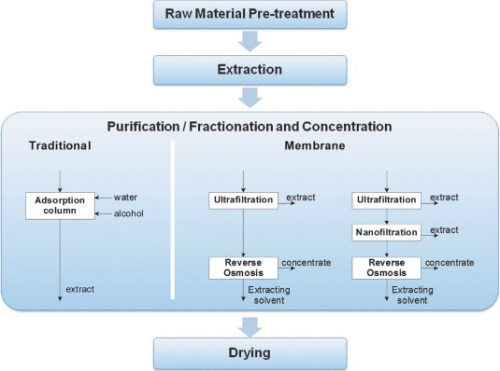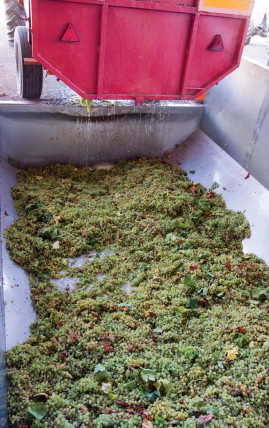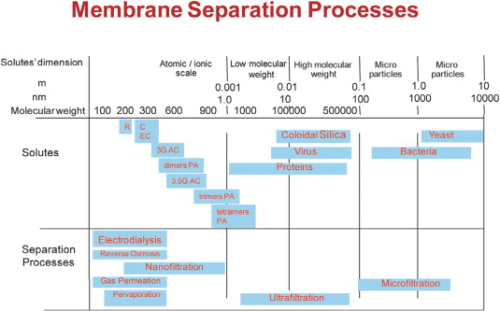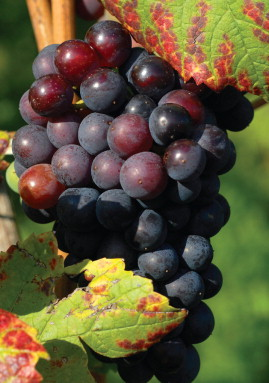![Figure 1. Simplified winemaking process. (adapted from [1])](/media/xazjp1uv/ea80e09c-1d1d-4839-a057-824b133644cd.jpeg)




A pdf version of this article is available on the right-hand side under 'Downloads'
During the winemaking process vast amounts of waste by-products are produced within a short period of time. The focus of this article is on the most significant grape processing residues (see Figure 1):
1. Pomace: a solid material consisting mainly of skins and grape seeds, which is separated from the juice in the pressing step (white wine fermentations), or from the wine (in red wine fermentations);
2. Grape seeds: usually obtained from pomace and;
3. Lees: a solid material consisting of deposits such as yeast, particles that precipitate, seeds, fining agents, etc, settled to the bottom of wine containers.
The annual production of grape pomace, resulting from winemaking, is estimated to range from 5-14.5 million tons in Europe [2].
Traditionally, winemaking by-products are used in animal feed or as fertilizers in vineyards. Despite their high content in valuable biologically active compounds, these by-products have a low market value when used as fertilizers or animal feedstocks. Additionally, their use as fertilizers may lead to plant germination problems, due to their high content in phenolic compounds [2]. Interestingly, these phenolic compounds have an extremely high market value as food additives, nutraceuticals and cosmeceuticals, due to their biological activity.
Biologically active compounds
The recovery of valuable biologically active compounds from wine by-products is well documented. The most common approaches are directed towards the production of natural grape extracts, where several active compounds are present. Grape seeds have one of the highest concentrations of monomeric proanthocyanidins reported in a fruit. On the other hand, resveratrol is the phenolic compound with the highest antioxidant activity in grapes, although less concentrated.
The World Health Organization states that the moderate consumption of wine, especially red wine, may reduce the risk of coronary heart diseases by 40%. The French Paradox study [5] was one of the first relevant works focusing on the beneficial biological activity of the grape compounds. Particularly, it was concluded that a clear relation exists between a moderate wine consumption and a low rate of cardiovascular diseases in France, despite a national diet rich in highly saturated fats.
The recognised antioxidant properties of the phenolic compounds are based on their ability to scavenge free radicals, inhibiting the oxidation of low-density-lipoproteins (LDL) related with atherosclerosis, thrombotic tendencies and heart diseases [6]. Flavonoids, also present in wine by-products, were reported to reduce inflammatory reactions in the body. Additionally, polyphenols offer anti-ulcer, anti-carcinogenic, anti-mutagenic [7] and antibacterial properties.
Market opportunities for natural extracts
The production of extracts, where different biologically active compounds recovered from grape by-products are present, has been claimed as the most attractive approach. Actually, several studies have shown that extracts may exhibit higher biological activity than purified compounds, due to positive synergetic interactions between the different compounds present. The challenge remaining is the production of these extracts with a desirable balance of target constituents, free of compounds with detrimental properties (for example, pesticides and heavy metals), using a recovery process that allows the label ‘natural’ to be used. This label can be only applied if bio-compatible solvents are used and the operating conditions (namely temperature) do not lead to a loss of the biologically activity of the target compounds.
Due to their potential health benefits, the production of grape extracts represents a good business opportunity that allows companies to target different markets. A particular emphasis should be given to the emerging profitable markets of natural ingredients for functional foods and natural cosmetics, as well as the market for dietary supplements.
The health and wellness consumer trend is increasing in importance, which is partly explained by populations in developed countries that are getting older and with increasing weight problems. Moreover, the growing awareness of the link between diet and health has converted natural extracts into a particular attractive market. As an example, the market for phenolic compounds was estimated to be worth over €100 million by Danisco.
In recent years, the global functional foods market has been estimated to reach €175 billion in 2012 by Euromonitor, a 45% increase over the 2007 value. Functional foods and beverages have been entering the food market on a regular basis. Natural extract additives have been introduced with different functions such as natural antioxidants, pigments (anthocyanins), and food preservatives. Regarding the natural cosmetics market, sales in France increased by 40% in 2005, according to a Frost & Sullivan report.
Producing grape extracts
In order to define a suitable production process for a natural grape extract, it is first necessary to specify the desired composition of the natural extract by defining the target compounds, and their relative balance. Additionally, the control of hazardous contaminants (such as heavy metals and pesticides) in the final product is a key issue.
There are several processes described for obtaining grape extracts, potentially rich in phenolic compounds, but all of them include the steps presented in Figure 2.
In first place raw material pre-treatment is where the wine by-products are milled in order to obtain homogenous small particles with high interfacial area. This increases the extraction efficiency of the target compounds.
The aim of extraction is to recover the target phenolic compounds from the complex natural matrix in which they are bound into. The extraction step has to be conducted under controlled and mild conditions, which represent the optimal compromise between the degree of extraction of the target compounds and the safeguarding of their biological activity.
For this reason the extraction step usually takes place under mild temperature and, frequently, under controlled atmospheric conditions (nitrogen blanket), in the absence of light. In addition, antioxidant compounds, such as sulphur dioxide and butylated hydroxytoluene (BHT, known as E321) can be added in order to avoid the tendency of the phenolic compounds to oxidise.
The extracting solvents water and ethanol have the advantage of being regarded as biocompatible, in line with the new REACH regulation, which is very strict regarding toxic solvents. These solvents, or combinations of the two, do not compromise the use of the label ‘natural’ in the final product and involve lower costs of disposal.
In order to increase the efficiency of aqueous extraction, an enzymatic pre-treatment may be performed. Cellulases, which hydrolyse plant polysaccharides and/or pectinases that break down pectin from the cell walls of plants are the most widely used. Besides improving the settling and the filterability of the juice or wine, this enzymatic treatment also positively affects the extraction yields of most phenolic acids, flavan-3-ols and anthocyanins.
The use of acidic conditions is also common in solvent extraction, particularly with mineral acids, such as hydrochloric acid [8]. Acidic conditions break glycoside bonds, which helps lowering the cloudiness of the extract, and releases phenolic compounds of interest, such as anthocyanins.
After extraction, a purification process should be performed in order to remove the typically large amounts of undesirable compounds present, such as fats, proteins and sugars, which react with the target phenolic compounds potentially reducing their antioxidant activity. Moreover, the removal of microorganisms and toxic substances is highly desirable. For example, the mould Aspergillus carbonarius, that may be present in the grapes, produces the mycotoxin Ochratoxin A.
The traditional purification process is performed by adsorption chromatography (see Figure 2, Traditional). In this process, the phenolic compounds present in the solvent phase are preferentially adsorbed to a copolymer of trimethylolpropane trimethacrylate (TMPTMA), commercially available as XAD-7HP®. Then, a water stream is circulated through the column, in order to remove water soluble impurities. Finally, in the elution step, a hydro-alcoholic solution is used for recovering the bound phenolic compounds from the column. [8].
The hydro-alcoholic stream, enriched in the target phenolic compounds, is then dried by evaporative techniques in order to obtain a final product with the specified characteristics (either a solid powder or a concentrated liquid phase).
Membrane separation processes
There is a multitude of grape-based extracts on the market, produced according to the process described above (see Figure 2, Traditional) or by variations of the process. However, this process does have significant limitations and drawbacks:
1. It does not allow flexible design of extracts enriched in specific target compounds; the extract composition is essentially determined by the by-product feedstock used and the extraction procedure selected;
2. It involves the use of large solvent to final product mass ratios, which impacts on the process economy and its environmental benignity;
3. It produces a large volume of brine solutions, used for regeneration of the adsorbent material between consecutive cycles.
Membrane processes offer a very powerful alternative for the production of natural grape extracts, due to their flexibility and mild operating conditions. Membrane processes have already been widely accepted in the food industry, particularly in the winemaking industry for sterile filtration before bottling, correction of must or wine by adjusting the sugar levels, and for tartaric stabilisation of wine.
Membrane processes, such us as ultrafiltration, nanofiltration and reverse osmosis, are pressure driven processes which allow compounds to be retained within a specific range of molecular masses (see Figure 3). Solute rejection/transport through these membranes is explained by molecular size exclusion mechanisms, as well as by additional Coulombic and hydrophobic interactions between the compounds present and the membrane selective layer. Therefore, beside an adequate selection of the membrane tightness (pore size in the case of ultrafiltration membranes), selection of the membrane materials is extremely important for assuring good membrane stability in the presence of the main solvent and a low adsorption of solutes.
In order to avoid solute adsorption (and fouling) the membrane should exhibit low affinity towards the solutes. On the other hand, to ensure high fluxes of the solvent, they must exhibit a high affinity towards the membrane. In particular, hydrophilic membranes should be used when processing aqueous and hydroalcoholic streams containing phenolic compounds with a hydrophobic behaviour. Several materials are appropriate for this purpose and a large range of commercial membranes and modules are available on the market, namely using spiral-wound polyamide membranes.
Production of natural grape extracts with membrane processes offers significant advantages over traditional processes:
1. Due to the large variety of membrane materials (polymers and composites) and structures (from ultrafiltration to nanofiltration) membranes offer the possibility of obtaining different fractions enriched in diverse target compounds, for specific applications and markets. In practice, this translates into the possibility of obtaining fractions enriched in target phenolic compounds with different degree of polymerisation (see Figure 2). For example, the recovery of monomeric and oligomeric compounds may be aimed for or, alternatively, the recovery of polymeric compounds. The use of appropriate nanofiltration membranes, allows for obtaining fractions enriched in phenolic compounds with low molecular mass (in the permeate), while a different membrane selection may allow for production of a different fraction. Cascades of membranes with different molecular cut-offs will allow for the collection of the fractions of interest (as happens currently for the fractionation of milk whey).
2. Control of undesirable products is achieved to a much greater extent. For example, when recovering a target extract as a permeate stream in a nanofiltration process, the exclusion of heavy metals is assured due to the ability of these membranes to reject di- and multi-valent ions.
3. The ecological footprint of these processes is typically lower because of lower solvent to final product mass ratios. Additionally, membrane processes operate under mild temperature and pressure conditions.
4. Finally, it is worth mentioning that membrane processes may also be used in the final concentration/drying step, namely by using reverse osmosis. This technique is economically favourable for solvent removal up to an osmostic pressure difference of not, vert, similar40 bar, above which evaporation is more competitive (see Figure 2).
According to the final product specification, different drying processes may be used, namely evaporative techniques under reduced pressure and mild temperature.
References
1 R.E. Kunkee, Introduction to Winemaking – Viticulture and Enology 3, Summer 2005, Department of Viticulture and Enology, University of California, Davis.
2 D. Kammerer, A. Claus, R. Carle and A. Schieber, Polyphenol Screening of Pomace from Red and White Grape Varieties (Vitis vinifera L.) by HPLC-DAD-MS/MS, J. Agric. Food Chem. 52 (2004), p. 4360. Full Text via CrossRef | View Record in Scopus | Cited By in Scopus (66)
3 T. Fuleki and J.M. Richardo da Silva, Catechin and Procyanidin Composition of Seeds from Grapes Cultivars Grown in Ontario, J. Agric. Food Chem. 45 (1997), p. 1156. Full Text via CrossRef | View Record in Scopus | Cited By in Scopus (81)
4 B. Sun, A.M. Ribes, M.C. Leandro, A.P. Belchior and M.I. Spranger, Stilbenes: Quantitative extraction from grape skins, contribution of grape solids to wine and variation during wine maturation, Analytica Chimica Acta 563 (2006), p. 382. Article | PDF (343 K) | View Record in Scopus | Cited By in Scopus (22)
5 S. Renaud and M. De Lorgeril, Wine, alcohols, platelets and the French paradox for coronary heart disease, Lancet 339 (1992), p. 1523. Article | PDF (573 K) | View Record in Scopus | Cited By in Scopus (1489)
6 E.N. Frankel and A.S. Meyer, Antioxidants in Grapes and Grape Juices and Their Potential Health Effects, Pharm. Biol. 36 (1998), p. 14. Full Text via CrossRef | View Record in Scopus | Cited By in Scopus (15)
7 H. Nawaz, J. Shi, G.S. Mittal and Y. Kakuda, Extraction of polyphenols from grape seeds and concentration by ultrafiltration, Separ. and Purific. Technol. 48 (2006), p. 176. Article | PDF (255 K) | View Record in Scopus | Cited By in Scopus (17)
8 Process for extraction, purification and enrichment of polyphenolic substances from whole grapes, grape seeds and grape pomace, US6544581.





